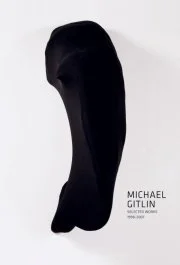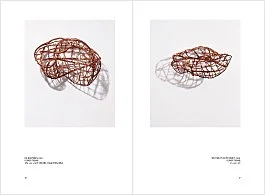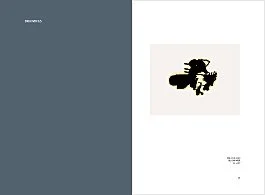Schüppenhauer Gallery + Projects 2007
Michael Gitlin: Informed Form
by Richard Kalina
Michael Gitlin’s body of work from 1998-2007 — an expansive but integrated group of wall-mounted sculptures and drawings — shows an artist grappling with a particularly challenging set of problems. While many referential, iconographic, and semiotic factors contribute to our understanding of sculpture, what lies at the heart of the modern approach to the medium is the issue of form. This is especially true with abstract sculpture. Gitlin’s work from this period deals with the under-explored and immensely intriguing arena of amorphous form. (By amorphous form I mean closed, bounded shapes in either three or two dimensions with no discernable ordering or measuring system.) The perceptual root of amorphous form is the natural world. While more obviously structured and ordered form (in life and art) seems clearly goal-directed, the driving forces and the aims of amorphous form are less easy to ascertain.
We can look at examples of ordered form in nature, human culture, and art. In nature, a crystalline structure is modular and builds on itself; in human culture, bricks and I-beams fit together to make rational buildings; in art, the grids, stacks and boxes of Minimalism engender a seemingly endless catalogue of lucid theme and variation. But what of amorphous form? In nature, amorphous form is more likely to be seen as the generated rather than the generator. Billowing smoke, clouds, and hill formations, for example, present themselves as the products of physical forces that operate with so many variables as to be virtually impossible to predict (except to some extent with chaos theory). Many vegetal forms share this sense of morphological variability, but human and most animal forms, while curved, are symmetrical and thus appear to our eyes to be logically ordered. Art could take this human symmetry and distort it for expressive purposes. The pre-modern period was replete with this; the Baroque in particular used contorted poses to disturb the body’s symmetry and increase drama. In modern art, however, amorphous form has largely resided in two areas. One is process-oriented art, where the natural properties of polyurethane, molten lead, or the like, when subjected to simple maneuvers by the artist, dictate the final result. The other is surrealism. A staple of surrealism is the biomorphic, which takes organic form, distorts it, and uses it as a sign for the uncanny.
Michael Gitlin’s recent sculptures tip their hat to surrealism, particularly to Arp, and to certain aspects of post-Minimalism, but quickly move off into new territory. The sculptures have a formal ambiguity combined with a material and perceptual lightness (in this they are the anti-Serras) that is all their own. They start with an armature, and sometimes, as in Re-sheltered (2003) and You Take It As You Find It (2003) end there. Gitlin’s armature is a three-dimensional grid of copper tubing, bent and torqued, so that the interior space it models is dynamically configured. The form is a restless one, and when placed on the wall, which acts as a sort of displaced pedestal, it seems to be simultaneously at home and ready to squirm away from you. When Gitlin leaves the armature as is, the airy interplay of interior and exterior is fascinating, as is the deformation of the grid. This mode of working is not only open in form, but seemingly open-ended in possibilities. For example, in a recent work, Open Question (2007), he bakes a perfectly matte-black finish onto the tubing, which emphasizes the vertical sculpture’s linear qualities and its mastery of drawing in space. Of particular interest in the open works, is the way that the rhythm of the linear intersections is punctuated by the spiky black drywall screws used to join the overlapping pieces.
When Gitlin covers the armature, however, something new enters the picture. On the human body, skin overlays bone, a separate referential system (and organ) but one formed by its underpinnings. Similarly, Gitlin’s covered forms both reflect and hide their structural origins. Surface is accentuated, and topographic variation becomes a key element. Gitlin has covered these sculptures with either stretchy black spandex, a white, cloud-like synthetic cotton wool, or gray steel wool. The dark, non-reflective spandex, while the most skin and membrane-like, is the least overtly referential of the coverings. The spandex-covered sculptures might at times suggest the body in motion or repose (this is clearest in Dark Matter [2004], whose spread out arms recall a swimmer poised to dive and the imposingly-scaled In and Out of Time [1998] which brings to mind an ear, or possibly a bird’s or an angel’s wing.) But Gitlin’s black forms, while evocative, are mysterious at their core. Unseen internal forces seem to pull and tug at the shape, ready to unsettle its tenuously poised balance.
The white synthetic cotton wool covered pieces, like White on White for Kasimir (2003) float cloud-like on the wall. They feel more dimensionally stable than the spandex pieces, but they are scarcely grounded. They are airy and witty, seemingly ready to play their part in a sculptural ballet scored by Eric Satie. The sculptures covered in steel wool, such as Reluctant Presence (2007), are among Gitlin’s most recent work. They share some of the properties of the other two kinds of sculpture — the spandex’s optical density and the synthetic cotton wool’s tactility and referentiality (in this case both to hair and to industrial processes). They have, however, a darker edge. Their visceral attraction combined with a “don’t touch me” quality sets up an interplay that adds a layer of psychological complexity to their formal beauty.
Mention should also be made of Gitlin’s large drawings. Casually elegant gestural pours of oil paint on paper, they subtly limn the shapes the artist creates in his sculptures, their implicit volume enhanced by the halation of oil medium that spreads out from the pigmented areas. While they might imply three-dimensional form, they nevertheless maintain the flatness of two-dimensional work. They sit on the page in the same stance as the sculptures, charged and resonant, but a bit out of plumb and seemingly ready for some kind of transformation. They are unmistakably a sculptor’s drawings — not working sketches or plans, but rather objects charting an evocative parallel path.
Michael Gitlin’s work of the last several years continues his explorations into the nexus of form and content. That he has elected to operate in an arena as potentially productive as the amorphous is a smart and bold choice, although scarcely a sure-fire one. To model abstract form in new ways, as he has, while making sure that equal justice is done to materiality and psychology, to art history and to pure form, speaks volumes about Gitlin’s ambition and his talent.


